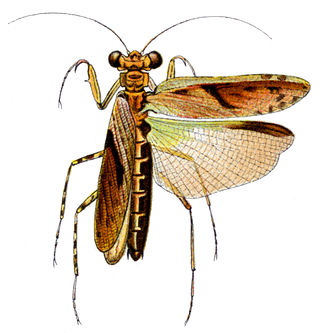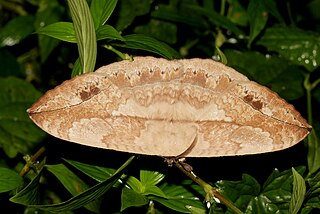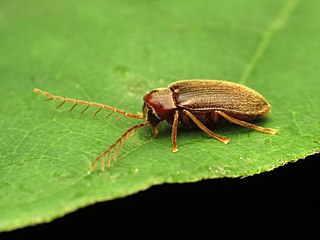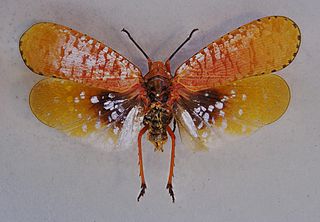
Tiger beetles are a family of beetles, Cicindelidae, known for their aggressive predatory habits and running speed. The fastest known species of tiger beetle, Rivacindela hudsoni, can run at a speed of 9 km/h, or about 125 body lengths per second. As of 2005, about 2,600 species and subspecies were known, with the richest diversity in the Oriental (Indo-Malayan) region, followed by the Neotropics. While historically treated as a subfamily of ground beetles (Carabidae) under the name Cicindelinae, several studies since 2020 indicated that they should be treated as a family, the Cicindelidae, which are a sister group to Carabidae within the Adephaga.

Félix Édouard Guérin-Méneville, also known as F. E. Guerin, was a French entomologist.

Amorphoscelidae is a family of mantises in the order Mantodea.

Apteromantis aptera is a species of praying mantis endemic to the Iberian Peninsula. It was first described by José María Hugo de la Fuente Morales in 1894. It was previously considered to be endangered by the IUCN, but has been downgraded to least concern, as the populations are rising and they are spreading to new habitats in south-central Spain and southern Portugal.

Deroplatys is a genus of mantis in the family Deroplatyidae. They are native to Asia and several share the common name of dead leaf mantis.

Rutilia is a large genus of medium to large (>20mm) flies in the family Tachinidae native to Australia and the Oriental region, though notably absent from New Zealand. Like the vast majority of tachinid flies, Rutilia species are parasitoids of other insects, specifically Rutilia are known to be parasitoids of late instar larvae of scarab beetles.

Dysphania is a genus of colourful moths in the family Geometridae and typical of the tribe Dysphaniini; they are sometimes called 'false tiger moths' and are found in northeast Australia, Melanesia, and south, east and southeast Asia.
Cneoglossidae is a family of beetles in the superfamily Byrrhoidea, containing nine described species in a single genus, Cneoglossa, which are native to the Neotropics from Mexico to Brazil. The larvae develop inside rotting submerged branches found in small fast flowing shallow streams.
Deroplatyini is a tribe of the subfamily Deroplatyinae of the family Mantidae of Mantodea.

Eupterote is a genus of moths in the family Eupterotidae. It was first described by Jacob Hübner in 1820.

Cirrochroa emalea, the Malay yeoman, is an Indomalayan species of heliconiine butterfly described by Félix Édouard Guérin-Méneville in 1843.

Cicindelini is a tribe of tiger beetles in the family Cicindelidae, containing the overwhelming majority of genera and species in the family. There are more than 90 genera and 2,000 described species in Cicindelini.

Ptilodactylidae is a family of beetles belonging to the Elateriformia. There around 500 extant species in 35 genera. They are generally associated with riparian and aquatic habitats. The larvae generally live associated with rotting wood or vegetation, or within gravel and detritus on the edge of water bodies. The larvae of some species feed on submerged rotting wood or on plant roots, while the adults of some species are known to feed on fungus with modified brush-like maxillae.

Sacodes is a genus of marsh beetles in the family Scirtidae. There are about seven described species in Sacodes.

Elodes is a genus of marsh beetles in the family Scirtidae. There are more than 60 described species in Elodes.

Melalgus is a genus of horned powder-post beetles in the family Bostrichidae. There are more than 20 described species in Melalgus.

Aphaena is a genus of planthoppers in the sub-family Aphaeninae of Fulgoridae. Species are distributed from eastern India, Indo-China, China and Malesia.

Perlamantis is a genus of praying mantids in the family Amorphoscelidae. Species records are from Northern Africa and the Iberian peninsula.

Eurybrachys is a genus of bugs in the family Eurybrachidae. First formally named in 1834 by French entomologist Félix Édouard Guérin-Méneville, Eurybrachys is the type genus of the family Eurybrachidae. The spelling Eurybrachis, by the author, is considered an unaccepted orthographic variant. Species in this genus occur in Asia.

















